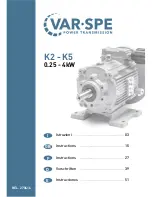
Clean the primary fuel filter. Fill with calibration
fluid or kerosene. Install the primary fuel filter and
operate the priming pump. This procedure will
send clean oil to the secondary filter and the
engine.
Open the fuel tank drain valve in order to drain any
water and dirt from the fuel tank. Apply a spray of
calibration fluid or kerosene at the rate of
30 mL per 30 L (1 oz per 7.50 gal US) of fuel tank
capacity in order to prevent rust in the fuel tank.
Add 0.15 mL per L (.02 oz per 1 gal US) of
commercial biocide such as Biobor JF to the fuel.
Apply a small amount of oil to the threads on the
fuel tank filler neck and install the cap. Seal all
openings to the tank in order to prevent
evaporation of the fuel and as a preservative.
9.
Remove the fuel injectors. Apply 30 mL (1 oz) of
the mixture of oils (50 percent VCI oil and 50
percent engine oil) into each cylinder.
Use a bar or a turning tool in order to turn over the
engine slowly. This procedure puts the oil on the
cylinder walls. Install all fuel injectors and tighten to
the correct torque. Refer to Disassembly and
Assembly Manual for more information.
10.
Spray a thin amount of a mixture of 50 percent
VCI oil and 50 percent engine oil onto the following
components: flywheel, ring gear teeth and starter
pinion. Install the covers in order to prevent
evaporation of the vapors from the VCI oil.
11.
Apply a heavy amount of Multipurpose Grease to
all outside parts that move, such as rod threads,
ball joints, linkage.
Note:
Install all covers. Ensure that tape has been
installed over all openings, air inlets, exhaust
openings, the flywheel housing, the crankcase
breathers, the dipstick tubes.
Ensure that all covers are airtight and
weatherproof. Use a waterproof weather resistant
tape such as Kendall No. 231 or an equivalent.
Do not use duct tape. Duct tape will only seal for a
short time.
12.
Under most conditions, removing the batteries is
the best procedure. As an alternative, place the
batteries in storage. As needed, periodically
charge the batteries while the batteries are in
storage.
If the batteries are not removed, wash the tops of
the batteries until the tops are clean. Apply an
electrical charge to the batteries in order to obtain
a specific gravity of 1.225.
Disconnect the battery terminals. Place a plastic
cover over the batteries.
13.
Remove the drive belts from the engine
14.
Place a waterproof cover over the engine. Ensure
that the engine cover is secure. The cover should
be loose enough to allow air to circulate around the
engine in order to prevent damage from
condensation.
15.
Attach a tag with the storage date to the engine.
16.
Remove the waterproof cover at 2 month or 3
month intervals in order to check the engine for
corrosion. If the engine has signs of corrosion,
repeat the protection procedure.
Coolant System
Completely fill the cooling system before storage.
Refer to this Operation and Maintenance Manual,
“Fluid Recommendations” for more information about
coolants.
Remove Engine from Storage
1.
Remove all outside protective covers.
2.
Change the oil and filters.
3.
Check the condition of the fan and alternator belts.
Replace the belts, if necessary. Refer to this
Operation and Maintenance Manual, “Belts -
Inspect/Adjust/Replace” for the correct procedure.
4.
Replace the fuel filter elements.
5.
Remove the plastic covers from the air cleaner
elements.
6.
Use a bar or a turning tool in order to turn the
engine in the normal direction of rotation. The
procedure ensures that no hydraulic locks or
resistance exist.
7.
Before starting the engine, remove the valve cover
or covers. Put a large amount of engine oil on the
camshaft, cam followers, and valve mechanism in
order to prevent damage to the mechanism.
SEBU9074
23
Lifting and Storage
Product Storage





















